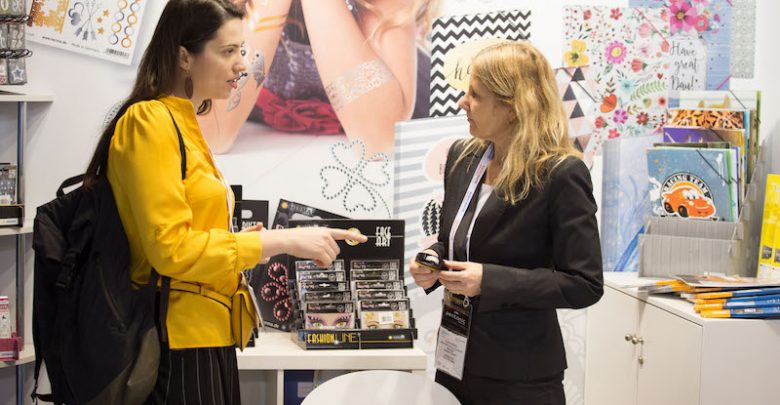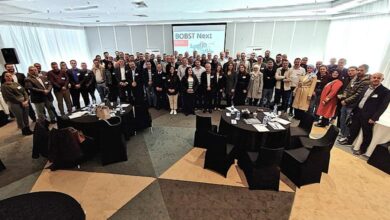Paperworld Middle East 2019 Concludes with 305 Exhibitors from 42 Countries

Paperworld Middle East, the region’s largest international trade fair for stationery, paper, gifts and office supplies, concluded in Dubai, featuring 305 exhibitors from 42 countries. The event ran for three days at the Dubai International Convention and Exhibition Centre. It is an annual showcase, which was opened by H. E. Butti Saeed Al Ghandi, Second Vice-Chairman of the Dubai World Trade Centre.
With a new ‘More than Paper’ theme for 2019 and beyond, the 9th edition of Paperworld Middle East opened with an expanded product offering, underlined by its co-location with Leatherworld, where 23 exhibitors presented their latest finished leather goods, from garments, footwear, and bags, to unique hand-crafted accessories and luxury gift ideas.
Other dedicated product groups across an increasingly diversified portfolio included the Corporate Gifts area, packed with unique promotional ideas, while the Playworld Village displayed the magical world of children’s toys and games.
A Green Room for sustainably produced stationery and office supplies was another show feature, along with a two-day seminar programme ensuring industry professionals and insiders were kept up-to-date with the latest Middle East market trends. “While Paperworld Middle East remains as the region’s largest dedicated trade fair for paper, stationery, and office supplies, we’re adding other key elements that leverage the synergies between related industries, further emphasising the trade fair’s ‘More than Paper’ theme,” said Alexandria Robinson, show director of Paperworld Middle East.
“We’re delighted to return with all the popular highlights, including Wrap Star, the UAE’s only gift wrapping competition, and as is customary, we’ve added something new for 2019: the Qualatex Mystery Box competition, which invites professionals to create their own balloon décor that’s becoming increasingly popular at weddings, parties, and special themed events across the region.
“Then there’s the show itself, where exhibitors are presenting their latest offerings, from school articles, creative materials, and office and business supplies, to premiums and branded gifts, and baby lifestyle products. Whether a wholesaler or distributor, a corporation or commercial end-user, a buyer of corporate gifts or an owner of toys, baby and kids stores, there is something for everyone at Paperworld Middle East,” Robinson added.
The European presence at Paperworld Middle East 2019 was particularly strong, with more than 50 exhibitors hailing from the old continent. Long-time exhibitor Olmar from Portugal was among these, and the company showcased its eco-friendly range of Fegol branded products for office supplies, and Pajory for school supplies.
João Oliveira, Olmar’s CEO said: “We’ve managed to grow our sales in the Middle East and African region by 45 percent over the past three years and we hope to improve on that record. We’re currently exporting to 32 countries and we plan to add at least another two countries to that list by the end of the year. We’ve created very good partnerships with all the distributors that we’ve met at Paperworld Middle East and we always come back to increase the recognition of our Pajory and Fegol brands.”
Stilolinea from Italy was another European exhibitor eager to capitalise on Paperworld Middle East 2019’s transregional reach. The Italian company was part of the Corporate Gifts section in 2019, and it shone the spotlight on its Italian Made range of promotional and gift writing pens.
Owner and Managing Director, Laura Chicco said: “Stilolinea is a 100 percent ‘Made in Italy’ company that has produced promotional and gift writing pens since 1972. The company is today not only one of the most important leaders in the European market, but has developed to become an internationally sought-after brand.
“What sets us apart is our collaboration with top contemporary designers, some of which are from high-end Italian companies such as Ferrari, Maserati, and Pininfarina,” added Chicco. “We also work with brilliant students from important Italian Universities such as the Turin Polytechnic. This is the origin of the Italian style and luxury, and is also the reason why our pens are loved by foreign markets.”
On the Middle East and African market, Chicco said: “These markets are very important to develop a parallel channel in which our Gift Line could be appreciated for the same high quality level of other well-known brands, but with the added bonus of very competitive prices.”
Meanwhile, spearheading the presence at Leatherworld Middle East was UAE Company Al Khaznah Tannery, which showcased the latest developments in its eco-friendly camel hide and derivative products. South African Footwear & Leather Export Council (SAFLEC), also returned with the finest exotic leather goods from South Africa. A dozen hand-picked brands were on display at the SAFLEC Pavilion, presenting their latest wares, from fashion accessories and footwear to décor interiors and corporate gifts.
And the Playworld Village was uncovering everything in the children’s toy sector, from construction toys, plush toys, and educational games, to children’s party items, and remote control or multi-functional toys. Distributors and household names such as Qualatex, Bingo, Cozydots, Coq En Pate, Funskool, Seetal and Party Centre were all out in force in this dedicated show section.
Thousands of regional trade customers also saw first-hand environmentally appropriate, socially beneficial and economically viable stationery and paper-based products at the Green Room. A helpful guide for any visitor eager to source sustainable products, the Green Room featured a smorgasbord of ethically produced goods from leading brands including Olmar, Double A, ITC, Bi-Silque, Bluecat Paper, The Navigator Company, Hindustan Pencils, Luxor, Rapesco, Salam Greetings, Smart Bags, and The Patchwood.





